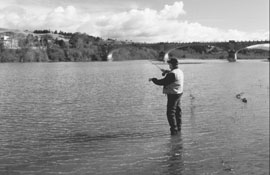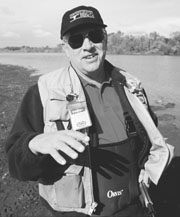



 IN 1904, THE CITIZENS OF UKIAH DREAMED UP A PLAN TO CREATE electricity by diverting the upper Eel River down a tunnel and through a hydropower plant. A few years later, the Potter Valley Project was lighting homes and powering industry in Mendocino County, but it also provided something much more valuable to farmers and landowners along the Russian River from Ukiah to Guerneville free water.
IN 1904, THE CITIZENS OF UKIAH DREAMED UP A PLAN TO CREATE electricity by diverting the upper Eel River down a tunnel and through a hydropower plant. A few years later, the Potter Valley Project was lighting homes and powering industry in Mendocino County, but it also provided something much more valuable to farmers and landowners along the Russian River from Ukiah to Guerneville free water.
Humboldt County didn't mobilize to fight that diversion. But in 1922, when another dam was proposed upriver to allow even more Eel River water to be diverted in the dry months, the Fortuna Business Men's Association, Eureka Chamber of Commerce and others vigorously opposed the project.
They lost. Now, 75 years later, after the water diversions have nearly wiped out runs of chinook salmon and steelhead in the upper Eel, local leaders and activists are trying again to recapture Eel River water.
Their window of opportunity is called Article 39. The Potter Valley Project, now owned by Pacific Gas and Electric Co., was re-licensed for 50 years in 1972. But a provision of that license Article 39 mandated that PG&E study how the Potter Valley Project affects Eel River fish and recommend a new "flow regime" to recover the fisheries.
The Humboldt County Board of Supervisors and many local conservation activists are urging federal dam licensing officials to adopt a flow regime developed by California Trout and Mendocino County's Covelo Tribe of Round Valley and endorsed by the U.S. Department of Interior. It would send more water down the Eel in the fall, when salmon and steelhead return to spawn, and in the spring when salmonid smolts migrate downstream to the ocean.
But the most controversial part of this flow regime is that it would increase by up to 2,000 percent the amount of water flowing down the upper Eel in the dry summer months. That is when the juvenile fish need water to survive, but it's also when farmers, citizens and river recreationists in the southern counties count on Eel-River water to keep the Russian River flowing.
"The battle is really going to be between the Russian River economy as opposed to the re-establishment of the salmon and steelhead fisheries in the Eel River," said Humboldt County Supervisor Stan Dixon, who chairs the Eel Russian River Commission.
Denver Nelson is a Eureka neurosurgeon who likes to fish. Twenty-five years ago he caught and released as many as five steelhead and salmon a day on the Eel River. As the stocks declined, he fished less and spent more time studying the Potter Valley Project and its impact on the river. He's a member of the county's Fish and Game Advisory Commission, and he recently testified at an environmental scoping session held by the Federal Energy Regulatory Commission, which holds the future of the Eel in its hands.
The Journal caught up with Nelson to talk to him about the future of the Eel.
NCJ: How does the Potter Valley Project affect the Eel River?
Nelson: It diverts almost the entire flow of the upper Eel River to the Russian River for six months of the year. For six months, all the water in the Russian River is Eel River water and there's almost nothing left for the Eel.
If there's no water in the upper part of the Eel in the fall, no fish can get up to spawn. And if you don't have enough flow in the spring, none of the juvenile (salmon) will get back down to
the ocean.
And there's more to it than that. In order to increase the summer flows from the Eel River to the Russian River, the Scott Dam was built upriver from the Cape Horn Dam in the 1920s. The water impounded behind it created Lake Pillsbury, which destroyed a great deal of salmon and steelhead habitat.
There were originally a lot of trout and bass in Lake Pillsbury, but somebody dumped bait minnows in the lake. Those minnows grew up to become squawfish, which ate all the trout and bass in the lake, and migrated throughout the Eel River basin to feast on juvenile salmonids.
If the current trend continues, the salmon and steelhead will
be obliterated. With improved water flow volumes and better timed releases, the salmon and steelhead should proliferate to historic counts and reach a balanced relationship with
squawfish as now occurs on the Sacramento River.
NCJ: How bad has it gotten for salmon and steelhead in the Eel?
Nelson: The fish that return to spawn come up a fish ladder at the dam and go into what looks like a hatchery holding pen. They count every fish, so it's one of the few places on the whole West Coast where they have absolutely accurate counts. They've been doing it since the 1930s. ... Back then, fish were returning in the many thousands 5,000 to 10,000 per year. It has declined to the point where four chinook salmon were counted in 1993.
You talk to old-timers who've been here 50 years and they'll tell you about walking across the river on the backs of fish, and it's probably true.
People are sitting in trees because they don't want sediment from logging in the rivers. There may be some truth to what they're saying, but (logging) is not as significant in the decline of fisheries as this project is.
NCJ: What's happening now?
Nelson: It's kind of unique and interesting. The FERC (Federal Energy Regulatory Commission) relicensing procedure happens every 50 years. This one came up in 1972 and PG&E now has a license to 2022. But a provision of that license was that PG&E had to do a study and establish a new water-flow proposal.
They came out with their new flow proposal in February, then FERC sent it off for an environmental impact statement which should be out in December. There'll be a public comment period after it comes out. Then the theory is that FERC adopts a flow proposal based on what the environmental impact statement says.
The problem is that this could move very, very slowly and the fisheries up in that area are in such a precarious state that if they don't change the flows soon and instead screw around with another 10 years of legal back and forth, there may not be any fish left in that part of that river to preserve.
NCJ: I understand the U.S. Department of Interior recently asked FERC to restore flows. Why are they involved?
Nelson: The Department of Interior is involved because of the Covelo Tribe (in Round Valley, downstream from the diversion) which has treaty fishing rights in the river. As part of its trust responsibility to the tribe, the Department of Interior recommended flow models to restore the fisheries.
I support the Department of Interior's flow model, as opposed to the other
proposed flow regimes. This relatively simple adjustment of the timing and volume of water flows will allow a resurgence of salmon and steelhead in the Eel River.
NCJ: What can people in Humboldt County do?
Nelson: I'm not an expert, just a country doctor. But I think it's going to come down to political clout. The problem is that all our (state and federal) representatives ... have to raise their money down south.
If you ask any of them about it when they're up here, they just clam up. If they said `We ought to run more water down the Eel,' then all the grape growers and canoeists down there would jump all over them. ... I do believe that our new congressman, (Mike) Thompson, is very aware of fisheries and a strong advocate for them.
I think the most important thing people can do is become informed about it. If you're on the Internet you can learn more than I know. ... Then get your comments into FERC. In the last year, 5,537 pages of comments have been submitted to FERC regarding the Potter Valley. Most of it has come from Sonoma County and PG&E.
Nelson suggests the following Internet sites for information about influencing the Federal Energy Regulatory Commission: amrivers.org/toolkit.html or snowcrest.net/chrc/resource.htm or ferc.fed.us/default3.htm or rimsweb1.ferc.fed.us/rims/ (Potter Valley is docket No. P-77.)
Comments? E-mail the Journal: [email protected]